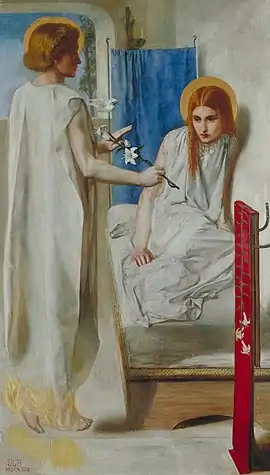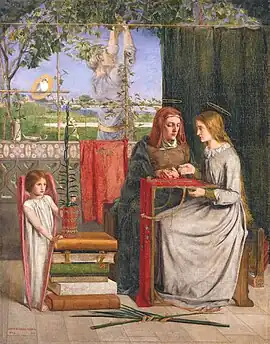Ecce Ancilla Domini
Ecce Ancilla Domini (Latin: "Behold the handmaiden of the Lord"), or The Annunciation, is an oil painting by the English artist Dante Gabriel Rossetti, first painted in 1850 and now in Tate Britain in London. The Latin title is a quotation from the Vulgate text of the first chapter of the Gospel of Saint Luke, describing the Annunciation,[1] where Mary accepts the message brought to her by the Angel Gabriel that she would give birth to a child (Jesus) by God.
| Ecce Ancilla Domini | |
|---|---|
 | |
| Artist | Dante Gabriel Rossetti |
| Year | 1850 |
| Medium | oil on canvas |
| Dimensions | 73 cm × 41.9 cm (29 in × 16.5 in) |
| Location | Tate Britain, London |
The title is more correctly Ecce Ancilla Domini!, but many sources ignore the exclamation mark.
Composition

Rossetti deliberately used a limited colour range for this oil painting. The predominance of white, symbolic of virginity, is complemented by vibrant blue (a colour associated with Mary, though notably not used in his The Girlhood of Mary Virgin in 1849) and red, for Christ's blood. Lilies are traditionally the symbol of Mary in Italian Renaissance art, but they are also considered funereal flowers, indicative of Christ's death.[2]
History
The artist's sister, Christina Rossetti, posed for Mary. As with her previous year's modelling, her brother altered her hair colour: in this instance, he made it auburn to continue the red palette. His brother William posed for Gabriel.
This painting received mixed reviews. The most obvious break with tradition was Rossetti's choice of placing Mary in bed - her long nightgown suggestive of a newly-wed bride - woken by the angel, who is normally depicted appearing as Mary prays. Also controversial were Gabriel's lack of wings (the flames at his feet suggest a Classical influence) and his obvious nakedness, glimpsed through the side of his robe. Note also the dove's halo, and the differences between Mary's and Gabriel's haloes, which may have arisen because Mary's was painted in 1850, whereas Gabriel's was not added until 1853.[3]
The painting was first exhibited in April 1850 at the Old Portland Gallery on Regent Street. Francis McCracken, a well known Pre-Raphaelite patron, bought it in 1853 for £50 and the Tate Gallery purchased it in 1886. In February 2013 it was not on display. The painting was on display at the National Gallery of Australia from December 2018 to April 2019 as part of the ‘Love & Desire: Pre-Raphaelite Masterpieces from the Tate’ exhibition.[4][5] As of 2023 it is on display at Tate Britain as part of 'The Rossettis' exhibition running until September 2023.
See also
References
- Luke 1:38: "dixit autem Maria ecce ancilla Domini fiat mihi secundum verbum tuum et discessit ab illa angelus".
- V. Surtees. Dante Gabriel Rossetti. Vol.I, Oxford: Clarendon Press (1971).
- J. Treuherz, E. Prettejohn, and E. Becker. Dante Gabriel Rossetti. London: Thames & Hudson (2003).
- Rossetti's Ecce Ancilla Domini, Smarthistory, accessed December 28, 2012.
- Ecce Ancilla Domini! (The Annunciation) 1849-50, Tate Gallery, accessed February 3, 2012.
Further reading
- Surtees, Virginia. (1971) Dante Gabriel Rossetti. 2 vols. Oxford: Clarendon Press.
- Ash, Russell. (1995) Dante Gabriel Rossetti. London: Pavilion Books ISBN 978-1-85793-412-0; New York: Abrams ISBN 978-1-85793-950-7.
- Doughty, Oswald (1949) A Victorian Romantic: Dante Gabriel Rossetti London: Frederick Muller
- Fredeman, William E. (Ed.) (2002-8) The correspondence of Dante Gabriel Rossetti. 7 Vols. Brewer, Cambridge.
- Hilto, Timoth (1970). The Pre-Raphelites. London: Thames and Hudson, New York: Abrams.
- Dinah Roe: The Rossettis in Wonderland. A Victorian Family History. Haus Publishing, London 2011, ISBN 978-1-907822-01-8.
- Rossetti, D. G. The House Of Life
- Treuherz, Julian, Prettejohn, Elizabeth, and Becker, Edwin (2003). Dante Gabriel Rossetti. London: Thames & Hudson, ISBN 0-500-09316-4.
- Todd, Pamela (2001). Pre-Raphaelites at Home, New York: Watson-Giptill Publications, ISBN 0-8230-4285-5.